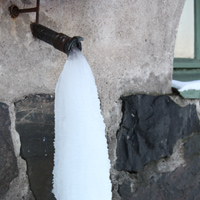 Now that winter has set upon us, the possibility of a frozen pump rises and this tool is essential to the waterproofing of your basement so it shouldn’t freeze. One handy tip to keep your pump from this perilous fate is to use a larger discharge hose. Discharge hoses attached to your sump pump are more likely to become blocked with ice if the water has a limited amount of space to pass through. This is why you should use a larger discharge hose on your pump than what manufacturers included, and in fact most pump’s discharge hoses can be removed and replaced easily. Its always a good idea to bury the end of the discharge hose in the ground before you insulate the section of pipe that runs above ground. If the ground is frozen, the pipe should be buried deep enough to bypass the full extent of the frozen surface. Also, when the discharge hose begins to freeze, the motor is forced to do more work, and therefore runs the risk of overheating and failing. Doing work around the foundation of your property to direct water away from the basement will give your pump some breathing room, and reduces the risk it will become blocked with water.
Now that winter has set upon us, the possibility of a frozen pump rises and this tool is essential to the waterproofing of your basement so it shouldn’t freeze. One handy tip to keep your pump from this perilous fate is to use a larger discharge hose. Discharge hoses attached to your sump pump are more likely to become blocked with ice if the water has a limited amount of space to pass through. This is why you should use a larger discharge hose on your pump than what manufacturers included, and in fact most pump’s discharge hoses can be removed and replaced easily. Its always a good idea to bury the end of the discharge hose in the ground before you insulate the section of pipe that runs above ground. If the ground is frozen, the pipe should be buried deep enough to bypass the full extent of the frozen surface. Also, when the discharge hose begins to freeze, the motor is forced to do more work, and therefore runs the risk of overheating and failing. Doing work around the foundation of your property to direct water away from the basement will give your pump some breathing room, and reduces the risk it will become blocked with water.
There are a few other methods used to keep your pump from failing this winter. For instance, laying the discharge pipe at a point so that the water’s exit is lower the pump itself will reduce the risk. Also, connecting a freeze-resistant hose to the end of your discharge pipe increases your protection against the frost, just be sure to aim for a distance of at least twenty feet away and use a smooth rigid hose so that there is no place possible for water to collect. Finally, depending on where the freezing of water is occurring, you may want to heat your basement to a temperature that allows the continued flow of water, not giving it a chance to freeze. By following these simple tips, you can save yourself plenty of money and keep your basement free from water, as well as keep that sump pump working to its optimum efficiency.
